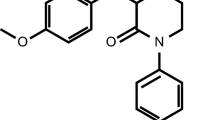Summary
Calcium channel blockers have been used in the treatment of primary and secondary Raynaud's phenomenon (RP), and a beneficial effect was often recorded. The efficacy of slow-releasing nicardipine was assessed in a clinically homogeneous series of RP without underlying diseases in a randomized, double blind, cross-over and placebo controlled trial. Out of twenty-one selected patients (18 women and 3 men, mean age 46±12 yrs) eighteen completed the study and three dropped out, one for inadequate compliance and two due to headache. After a threeweek period, slow-releasing nicardipine (20 mg two times daily) was significantly more useful than placebo: the number of RP episodes per week decreased (p<0.02), severity of discomfort and hand disability scores, evaluated after single RP attack, clearly improved (p<0.005 and p<0.02, respectively). According to clinical improvement, time of peak flow after postischemic reactive hyperaemia test was significantly reduced only after nicardipine (p<0.01). These results show that slow-releasing nicardipine is generally well tolerated and can provide effective improvement in RP patients without underlying diseases.
Similar content being viewed by others
References
Rodnan, G.P. Raynaud's Phenomena. Ed: McCarty DJ, In: Arthritis and Allied Conditions. 9th ed. Philadelphia: Lea and Febiger, 1979, 767–769.
Olsen, N., Nielson, S.L. Prevalence of primary Raynaud's phenomenon in young females. Scand J Clin Lab Invest 1978, 37, 761–764.
Maricq, H.R., Weinrich, M.C., Keil, J.E., LeRoy, E.C. Prevalence of Raynaud's phenomenon in the general population. J Chron Dis 1986, 39, 423–427.
Kallenberg C.G.M., Pastoor, G.W., Wouda, A. The T. Antinuclear antibodies in patients with Raynaud's phenomenon: Clinical significance of anticentromere antibodies. Ann Rheum Dis 1982, 41, 382–387.
Priollet, P., Vayssairat, M., Housset, E. How to classify Raynaud's phenomenon. Long term follow-up study of 73 cases. Am J Med 1987, 83, 494–498.
Smith, C.D., McKendry, R.J.R. Controlled trial of nifedipine in the treatment of Raynaud's phenomenon. Lancet 1982, 2 1299–1301.
Challenor, V.F., Waller, D.G., Hayward, R.A., Griffin, M.J., Roath, O.S. Vibrotactile sensation and response to nifedipine dose titration in primary Raynaud's phenomenon. Angiology 1989, 40, 122–128.
Kahan, A., Amor, B., Menkes, C. A randomized double-blind trial of diltiazem in the treatment of Raynaud's phenomenon. Ann Rheum Dis 1985, 44, 30–33.
Kinney, E.L., Nicholas, G.G., Gallo, J., Pontoriero, C., Zelis, R. The treatment of severe Raynaud's phenomenon with verapamil. J Clin Pharmacol 1982, 22, 74–76.
Rupp, P.A.F., Mellinger, S., Kohler, J., Dorsey, J.K., Furst, D.E. Nicardipine for the treatment of Raynaud's phenomena: A double-blind crossover trial of a new calcium entry blocker. J Rheumatol 1987, 14, 745–750.
Wigley, F.M., Wise, R.A., Malamet, R., Scott, T.E. Nicardipine in the treatment of Raynaud's phenomenon. Arthritis Rheum 1987, 30, 281–286.
Kahan, A., Amor, B., Menkes, C.J., Weber, S., Guerin, F., Degeorges, M. Nicardipine in the treatment of Raynaud's phenomenon: A randomized double blind trial. Angiology 1987, 38, 333–337.
Allen, E.V., Brown, G.E. Raynaud's disease: A critical review of minimal requisites for diagnosis. Am J Med Sci 1932, 183, 187–200.
Maricq, H.R. Widefield capillary microscopy: technique and rating scale for abnormalities seen in scleroderma and related disorders. Arthritis Rheum 1981, 24, 1159–1165.
Ferri, C., Bernini, L., Cecchetti, R., Neri, R., Latorraca, A., Marotta, G., Pasero, G., Bombardieri, S. Cutaneous and serological subset of systemic sclerosis. Their relevance in diagnosis, severity and prognosis of the disease. J Rheumatol 1991, 18 (in press).
Del Guercio, R., Leonardo, G., Arpaia, M.R. Evaluation of postischemic hyperemia on the skin using laser doppler velocimetry: study on patients with claudicatio intermittens. Microvascular Research 1986, 32, 289–299.
Smith, C.R., Rodeheffer, R.J. Raynaud's phenomenon: pathophysiologic features and treatment with calcium-channel blockers. Am J Cardiol 1985, 55, 154B-157B.
Kahan, A., Devaux, J.Y., Amor, B., Menkes, C.J., Weber, S., Venot, A., Guerin, F., Degeorges, M., Roucayrol, J.C. Nicardipine improves myocardial perfusion in systemic sclerosis. J Rheumatol 1988, 15, 1395–1400.
Russel, O., Kappagoda, T. Reactive hyperemia in patients with Raynaud's phenomenon. J Rheumatol 1988, 15, 1653–1657.
Author information
Authors and Affiliations
Rights and permissions
About this article
Cite this article
Ferri, C., Cecchetti, R., Cini, G. et al. Slow-releasing nicardipine in the treatment of Raynaud's phenomena without underlying diseases. Clin Rheumatol 11, 76–80 (1992). https://doi.org/10.1007/BF02207089
Received:
Revised:
Accepted:
Issue Date:
DOI: https://doi.org/10.1007/BF02207089




